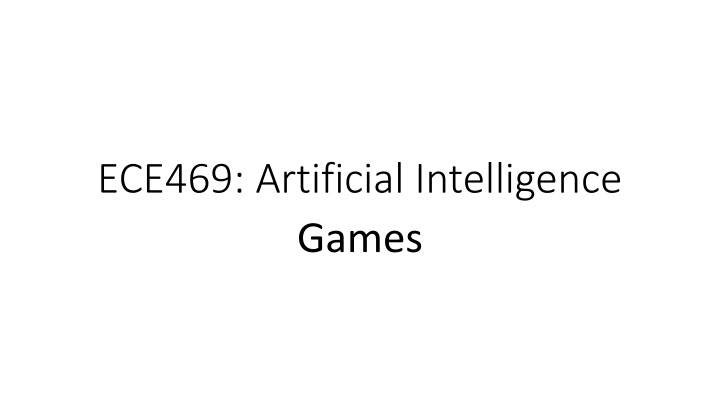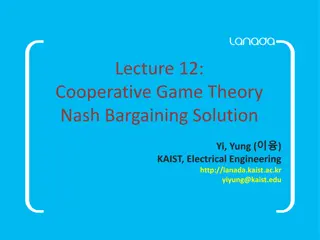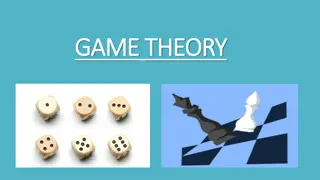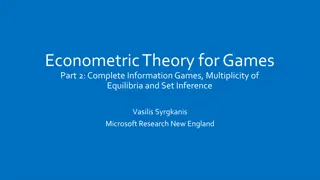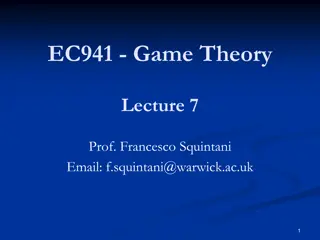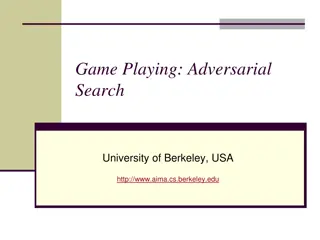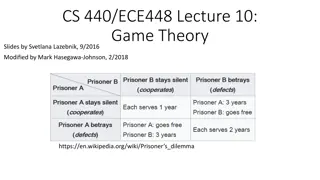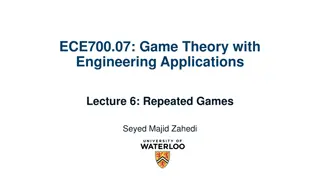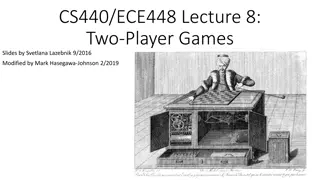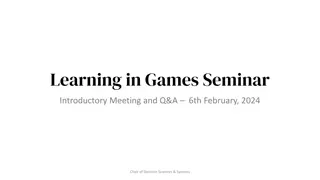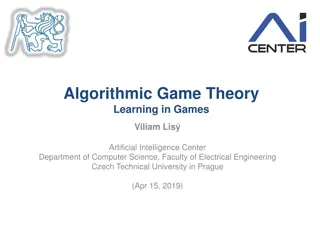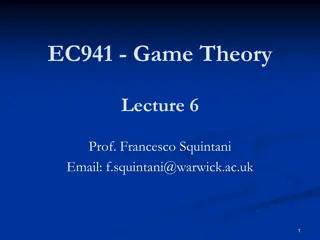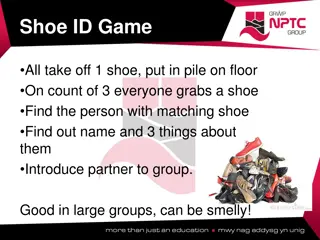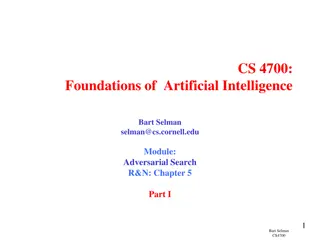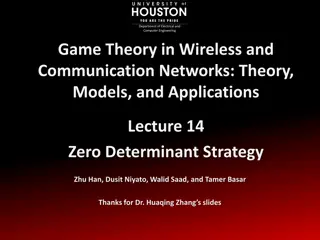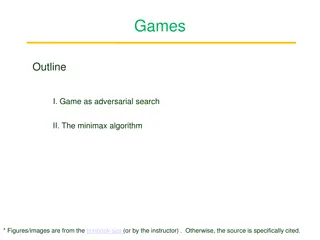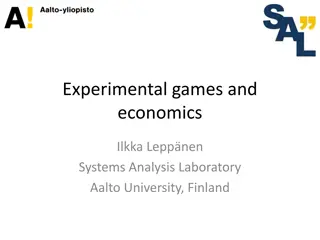AI Games: Competitive Environments and Game Theory
Competitive agents in AI games present adversarial search problems rooted in game theory, focusing on deterministic, two-player, turn-taking, perfect information, zero-sum games. Learn about defining games formally, components of a game, utility function, and game trees representation.
Uploaded on Mar 01, 2025 | 0 Views
Download Presentation

Please find below an Image/Link to download the presentation.
The content on the website is provided AS IS for your information and personal use only. It may not be sold, licensed, or shared on other websites without obtaining consent from the author.If you encounter any issues during the download, it is possible that the publisher has removed the file from their server.
You are allowed to download the files provided on this website for personal or commercial use, subject to the condition that they are used lawfully. All files are the property of their respective owners.
The content on the website is provided AS IS for your information and personal use only. It may not be sold, licensed, or shared on other websites without obtaining consent from the author.
E N D
Presentation Transcript
Games Environments with competitive agents give rise to adversarial search problems While these could, in theory, involve "real-world skirmishes", we will focus on games Game theory, often applied to economic situations, more generally concerns itself with multi-agent environments where the impact of agents on each other is significant Using terms from the 4thedition of the textbook, many games studied in AI are deterministic, two-player, turn-taking, perfect information, zero-sum games Although "deterministic" is listed here, according to the earlier definitions that we covered, the task environment is strategic (this term was dropped from the 4thedition) The term "perfect information" implies that the task environment is fully observable Zero-sum means that what is good for one player is equally bad for the other, and vice versa (we will discuss this in more detail later) We will focus mainly on this type of game, but some other types will be discussed a bit near the end of the topic
Defining a Game A game can be formally defined as a search problem with the following components: S0: The initial state; e.g., the board position at the start of the game TO-MOVE(s): A function that specifies whose turn it is at the given state ACTIONS(s): A function that returns the legal moves given a state RESULT(s, a): The transition model which defines the result of the specified move, or action, when applied at the specified state IS-TERMINAL(s): A terminal test, which determines if the game is over (final states for which the function is true are called terminal states) UTILITY(s, p): A utility function (a.k.a. objective function or payoff function), which gives a numeric value for terminal states with respect to the specified player Note that the utility function is only defined for terminal states For chess, the utility function might assign +1, -1, or 0 for a win, a loss, or a draw, respectively (or, as in the book, 1, 0, or 0.5, but that does not fit the zero-sum term well) For backgammon, values might range from +192 to -192 (the book says that scores range from 0 to 192, but utility should be centered around 0 in a zero-sum game)
Game Trees The initial state, legal moves (actions), and transition model define the state space graph, which we can consider to be a game tree Nodes in the game tree represent (or store) game states, and edges represent moves (made by alternating players in turn-taking, two-player games) When depicting game trees, we will be calling the two players MAX and MIN; we will typically assume that MAX moves first For a game like Tic-Tac-Toe, the game tree has fewer than 9! = 362,880 terminal nodes, and there are only 5,478 distinct states The figure on the next slide shows a partial game tree for Tic-Tac-Toe (but note that the terminal edges that are shown would be at different depths) For a game like chess, on the other hand, there would be over 1040nodes In some sources (including earlier editions of the AI textbook), when both players take a turn, that is considered one move, or two half-moves Each half-move is also known as a ply (this term is unambiguous) In other sources, when either player takes a turn, that is called a move, and this is typically what I mean when I refer to a move in this sort of game
Minimax Values In the sort of search problems that we covered in our previous two topics, the solution is a sequence of actions leading to a goal state In a game, your opponent (MIN, assuming you are MAX) "has something to say about it" MAX must find a contingent strategy; an optimal strategy will lead to outcomes as least as good as any other when playing an infallible opponent The optimal strategy can be determined by calculating the minimax value of each node: UTILITY(s, MAX) maxa ACTIONS(s) MINIMAX(RESULT(s, a)) mina ACTIONS(s) MINIMAX(RESULT(s, a)) if IS TERMINAL(s) if TO MOVE(s) = MAX if TO MOVE(s) = MIN MINIMAX(s) = I add: For the type of game we are considering, the minimax decision you make using this function maximizes the worst-case scenario (the book does not make this point clear) The opponent may not make the move you expect, but if not, you will do at least as well as you predicted based on a minimax search (using an algorithm we will soon cover) The next slide shows minimax values for a very simple (and, I would add, not fair) game tree
Minimax Search The next slide shows pseudo-code for minimax search, which is based on the function for minimax value We will look at a way to improve the efficiency of the search later Note that, for now, we are assuming that we can search the entire tree, so the exact value of every node is known I have a few comments about the pseudo-code: I don't really like the use of the "player" variable, which is used across the three shown functions without being passed, and therefore must be a global variable However, if it is a global, there is no reason to pass it to UTILITY Furthermore, the variable will always equate to the MAX player, since the non-recursive MINIMAX-SEARCH always starts with a call to MAX-VALUE This is because it is standard to always have the computer play as the MAX player; however, it is still possible for the MAX player to be playing with either set of pieces (e.g., white or black in a game of chess) This pseudo-code uses two different functions for MAX-VALUE and MIN-VALUE that call each other It is possible to combine them into a single function, and there are multiple ways to go about that One way is often referred to as negamax, which is not discussed in the textbook; it is not more efficient, but it leads to code that is more compact (we'll talk a bit more about this later, after we discuss alpha-beta pruning)
Minimax Search Complexity This algorithm, as we have covered it so far, performs a complete depth- first search (DFS) of the game tree Assume the maximum depth of the game tree is m and there are b legal moves per state Then the time complexity is O(bm) The time complexity is OK for a simple game like Tic-Tac-Toe, but not for games like chess, checkers, or Othello The space requirement is O(b * m) if all or actions or successors are generated at once The space complexity can be reduced to O(m) if one action or successor is generated at a time
Minimax with More Than Two Players In a game with more than two players, each node includes a vector of values (e.g., <va, vb, vc> for a three-player game) A sample game tree for a hypothetical, simple three-player game is shown on the next slide, with values indicated In a two-player, zero-sum game, the two-element vector can be reduced to one value because the two values will always be opposites Not explained in the textbook: This extended version of minimax no longer maximizes the worst-case scenario for a player The truth is that general multi-player games with more than two players are often much more complex than two-player games For example, deals and alliances are made (and sometimes broken)
Alpha-Beta Pruning A major problem with minimax search as describes so far is that the number of game states is exponential w.r.t. the number of moves To a large extent, this is unavoidable, but there is a way to improve the efficiency A search using alpha-beta pruning returns exactly the same move as a minimax search without alpha-beta pruning However, it does not consider, or even generate, most of the nodes in the game tree in most cases To implement this strategy, two new search parameters need to be added: (alpha) = the value of the best choice for MAX (i.e., the highest value) along the current path so far (beta) = the value of the best choice for MIN (i.e., the lowest value) along the current path so far With these changes, the search is known as alpha-beta search, a.k.a. minimax search with alpha- beta pruning The figure on the next slide, from the textbook, tries to help explain the intuition behind the parameters; we'll discuss my expanded version on the following slide
Alpha Beta Search As mentioned, when alpha-beta pruning is added to minimax search, the resulting algorithm is called alpha-beta search, a.k.a. minimax search with alpha-beta pruning The next two slides show pseudo-code for alpha-beta search; some things to point out: The pseudo-code is very similar to that for minimax search without alpha-beta pruning Note that the and parameters have been added to the MAX-VALUE and MIN-VALUE routines (which call each other) Each of these routines have two extra lines, compared to the previous version; one that updates and , and one that does the prune check These routines update alpha or beta before the prune check, but either order is fine NOTE: There is a potential bug if ties are broken randomly This is not true in the book's pseudo-code (if implemented as shown, this pseudo-code will always return the first move that ties for the best), but it might be true when you implement your first projects This potential problem can be avoided if the prunes in MAX-VALUE and MIN-VALUE, respectively, return v+1 and v-1 instead of v The figure on the slide after pseudo-code helps to step through an example from the textbook (I've corrected several mistakes) The slide after that shows a more complex example that I've created
Combining Recursive Functions When implementing minimax search with or without alpha-beta pruning, the two recursive functions that call each other can be combined into one recursive function With a straight-forward implementation, this requires an extra parameter indicating whose turn it is, and an if-else statement to separate the logic for each player Alternatively, when implementing alpha-beta search, some programmers like to always consider the current player (at all depths of the recursion) to be the MAX player Some sources call this variation of the implementation negamax Negamax is not discussed in the textbook, but you can find pseudo-code for it on-line easily When implementing the search this way, with each recursive call, - gets passed to and - gets passed to Also, the result of each recursive call gets negated The code for negamax is more compact, but probably more confusing to understand, and arguably more difficult to debug Whichever way you implement the strategy, the efficiency should be approximately the same, and the resulting move should be exactly the same Note that, up to this point, we're assuming you can search the entire game tree, which is obviously not feasible for most games in practice; we'll address this shortly
Ordering Moves The order in which moves are searched influences the effectiveness of alpha-beta pruning If moves were searched in perfect order (which is obviously impossible), for typical games, the number of nodes examined would be cut from O(bm) to approximately O(bm/2) If successors are searched in random order, the exponent is effectively cut by about 25% If the AI agent has a specific time limit for each move, this means that it can search twice as deep in the tree for the perfect case, and 4/3 as deep in the random case Game specific heuristics for ordering moves can generally achieve something in between For chess, reasonably simply ordering schemes can get you close to the theoretical limit; e.g., try captures first, then threats, then forward moves, then backwards moves Dynamic move-ordering schemes can also bring us close to the theoretical limit For example, if iterative deepening is used to search the game tree, we can use the evaluations from one stage to determine the order of moves searched at the start of the next stage We will also soon discuss another reason that iterative deepening will be important for your projects In general, as the agent searches deeper in the tree with pruning, a higher percentage of nodes are pruned at each sequential depth (in fact, a very high majority of nodes will be pruned in most cases)
Transposition Tables Transpositions are different permutations of moves that lead to the same position In games, this often leads to checking the same state over and over again A hash table of positions evaluated up to a certain depth (with their evaluations) is called a transposition table This allows you to avoid applying a search of the same state, to a specific depth, more than once Because game trees are exponentially big, you usually can't store all the evaluated state/depth combinations Strategies exist to choose which nodes to keep in the transposition table and which to discard According to the textbook, transposition tables can have a dramatic effect, sometimes as much as doubling the reachable depth in chess
Searching Exponentially Big Game Trees In real game-playing applications, we must avoid requiring minimax or alpha-beta search to search all the way to terminal nodes The terminal test is replaced by a cutoff test and the utility function is replaced by an evaluation function (a.k.a. a heuristic function) You can think of heuristic functions for games as approximating the level of goodness of a game position for a particular player (typically, the MAX player) The cutoff test can just check to see if the search has reached some specified depth When a time-limit is required instead of a depth-limit, iterative deepening can be used When the time-limit is about to be up, the recursion unwinds When this happens, the program should choose the move determined by the deepest completed search
Evaluation Functions The evaluation function, a.k.a. heuristic function, ideally should: order terminal states in the same order as the utility function (this is crucial) order other states based on the "chances of winning" be fast Conventional evaluation functions compute numeric contributions for various manually constructed features and combine them for a total value Some evaluations functions use a weighted linear function and can be expressed as: EVAL(s) = w1f1(s) + w2f2(s) + + wnfn(s) = i=1..N wifi(s) For example, for chess: The f-values might be the number of various types of pieces in chess The w-values could be the value of the piece (1 for pawn, 3 for bishop, etc.) In addition to material value, more advanced chess heuristics would include features related to concepts such as pawn structure, king safety, etc. In reality, the features are not always independent, so non-linear evaluation functions can sometimes work better
Creating Evaluation Functions Conventionally, the choice of features for an evaluation function is based on expert knowledge Weights can either be manually set or empirically determined Modern programs for various games sometimes learn the features as well as the weights When applied to terminal states, the evaluation function should evaluate to some multiple of the defined utility of the state Definite wins for MAX should get the highest weight (nothing else should be as high) Definite losses for MAX should get the lowest weight (the negation of the highest weight) Draws should be evaluated as 0 The evaluation function must be zero-sum (I don't think the book expresses this clearly) If you apply the evaluation function from the opposite player s point of view, the result should be the negated value of the current player s point of view This means that if you, for example, add one point for every one of the current player s pawns in a chess game, you must also subtract one point for every one of the other player s pawns As much as I tend to emphasize this, I have seen many students get it wrong; your programs will not play well if you don t get this right
Implementing Alpha-Beta Search When implementing the updated (i.e., with a depth cutoff) alpha-beta search, a few things in the pseudo-code need to change: You need an additional parameter indicating the current depth of the search, and each recursive call should pass the current depth plus one Replace IS-TERMINAL(state) with IS-CUTOFF(state, depth); note that actual terminal states also count as a cutoff Replace UTILITY(state, player) with EVAL(state, player) Remember that "player" seems to be a global variable in the pseudo-code that will always equate to MAX Thus, you may be able to avoid passing it as an argument to EVAL for your projects, depending on how you set up your code You could use a fixed depth limit as the cutoff, but it is better to use iterate deepening, which is necessary if there is a time limit, which will be the case for your projects When the time runs out, remember to select the move determined by deepest completed search
Quiescent Search Positions that are quiescent are unlikely to exhibit wild swings in value in the near future A quiescent search expands non-quiescent positions until quiescent positions are found This can be implemented by modifying IS-CUTOFF to return false for non-quiescent positions For example, in chess, positions in which a capture of the queen is possible would be non-quiescent, and should be expanded further I don't expect you to implement this for your projects
The Horizon Effect The horizon effect is more difficult to eliminate This occurs when serious damage is ultimately unavoidable, but it can be temporarily avoided by pushing the outcome beyond the search depth We will look at a couple of examples from chess (on the next slide) In the first example, the program may think it is ahead, even though it is doomed to lose In the second, the program may make poor moves to avoid losing a bishop, even though the loss of the bishop is inevitable As hardware improvements lead to deeper searches, the horizon effect occurs less often
Horizon Effect Examples Example from 2nd Edition Example from 3rd and 4th Editions
Other Potential Improvements A singular extension is a move that seems to be "clearly better" than all others in a given position Some programs allow the search to extend below the depth limit when singular extensions are recognized; this can help mitigate the horizon effect Some programs use forward pruning to prune moves that seem clearly bad, although this can be dangerous It is sometimes safe to prune one of two symmetrical moves I add: In the extreme (but not uncommon) case, if there is only one legal move, performing an alpha-beta search is irrelevant and wasteful Many existing game-playing programs use databases of common opening and endgame positions; thus, early and late in the game, no search occurs
Stochastic Games Stochastic games (which include random elements) are more difficult to deal with compared to deterministic (really, strategic) games For example, in backgammon you don't know what the legal moves will be because it depends on dice; there is no standard search tree To handle this, we can generalize the minimax value to an expectiminimax value as follows: UTILITY(s) maxa EXPECTIMINIMAX(RESULT(s, a)) mina EXPECTIMINIMAX(RESULT(s, a)) r P(r) EXPECTIMINIMAX(RESULT(s, r)) if IS TERMINAL(s) if TO MOVE(s) = MAX if TO MOVE(s) = MIN if TO MOVE(s) = CHANCE EXPECTIMINIMAX(s) = In the final row, r represents a possible dice roll or some other chance event The nodes in the game tree related to the chance events are called chance nodes An example of a game tree for backgammon is shown on the next slide
Properties of Expectiminimax The expectiminimax value is an expected value of a position if the opponent plays perfectly With expectiminimax search, we are no longer maximizing the worst-case scenario (the book does not make this clear) As with regular minimax search, we can search to some specified depth limit and then use an evaluation function There is also an extension of alpha-beta pruning that can be used (under certain assumptions) Now, however, we must be more careful with the evaluation function The value assigned to a position should be a positive linear transformation of the probability of winning Before, only the ranking order of positions mattered The time complexity changes from O(bm) to O(bmnm) where n is number of distinct random events This makes a huge difference in the number of moves that we can look ahead Nonetheless, expectiminimax search with a complex, manually constructed evaluation function can compete with top humans at backgammon
Partially Observable Games As part of a discussion of partially observable games, the text discusses Kriegspiel This is a variation of chess where players only see their own pieces, but a referee sees the entire board and only allows legal moves Players can propose moves on their turn until a legal move is found We are skipping the details, but one notion that reappears is that of belief states The book also discusses card games (e.g., bridge, hearts, and some forms of poker) in which cards are dealt randomly at the beginning of each game or hand These games are partially observable and stochastic In games such as these, and in Kriegspiel, it is often strategic to give away as little information as possible At times, this requires acting randomly in order to be unpredictable The book also mentions the notion of bluffing in poker
Monte Carlo Tree Search (basic) Methods involving Monte Carlo tree search (MCTS) have led to huge successes for certain games in recent years One example is Go; two factors of Go which hinder alpha-beta search are: There is a large branching factor (it is 361 at the start of the game) It is difficult to come up with a good evaluation function A basic MCTS strategy could just randomly play a bunch of games from the current position, starting from every possible move These random games would be examples of simulations (a.k.a. playouts or rollouts) The move that leads to the most wins could then be selected (so no heuristic would be used) This might lead to good moves against opponents who play randomly, but it does not generally lead to good moves against strong players for complex games
Monte Carlo Tree Search (better) It is better to rely on a playout policy, that bias moves toward good ones Early attempts at using MCTC for Go involved manually created playout policies, but recent attempts have used deep neural networks and reinforcement learning to learn playout policies The playout policy does not always start at the root of the search tree (the root represents the current position in the game at which the program needs to make a choice) Instead, a selection policy is used to choose which node to expand; this can combine two factors: We want to ensure exploration of states that have had few playouts so far We want to ensure exploitation of states that have done well in past playouts Selection starts at the root of the search tree and makes its way down to a leaf node; then an expansion step generates a new child of the leaf node (or multiple children can be generated) For each new node that is generated, a full simulation is performed starting at that node according to the playout policy; these moves are not recorded in the search tree At the end of each simulation, based on the result, a back-propagation step updates the statistics associated with nodes on the path from the root to the selected node
Stepping through an MCTS Example The figure on the next slide helps to explain one iteration of MCTS The darker circles indicate the number of wins for white (after one of white's moves) and the total moves explored The lighter circles indicate the number of wins for black (after one of black's moves) and the total moves explored It is currently black's move (to be played by the computer) In part (a), a selection policy is used, mostly taking exploitation into account; the dark arrows show the path to a leaf that is selected In part (b), a new child is generated and initialized (some implementations would generate multiple children here) In part (c), a single simulation is executed, according to a playout policy; black wins, and the results are back-propagated up the tree Note that the tree does not grow during the simulation
The State of AI Chess Deep Blue (the program that beat the world champion Garry Kasparov in chess in 1997) used an iterative- deepening alpha-beta search with a transposition table The search would generate extensions beyond the depth limit for interesting lines of forcing/forced moves The program routinely searched to a depth of 14 plies, but in some cases up to 40 The evaluation function used 8,000 features (weights were learned by analyzing master games) There was an opening book of 4,000 positions, a database of 700,000 grandmaster games, and a large database of solved endgames including all positions with five pieces of less The program ran on a chip specifically designed for Deep Blue Over the next two decades, algorithmic improvements led to increasingly good chess programs In late 2017, using techniques similar to those used for AlphaGo (to be mentioned soon), including Monte Carlo tree search, deep learning, and reinforcement learning, another major breakthrough occurred A system named AlphaZero, developed by Google's DeepMind subsidiary, after learning for one day, played the previously top-ranked chess program (Stockfish) in 100 games; it won 28 and drew the rest! However, development of Stockfish has continued, and some online commenters claim that newer versions of Stockfish would be competitive with, or better than, AlphaZero The 4th edition of the textbook states that the top chess programs today "far exceed human players"
The State of AI Checkers Chinook, developed at the University of Alberta in Canada, lost to Marion Tinsley in checkers (a.k.a. English draughts) in 1990 Tinsley had been the checkers world champion for over 40 years, losing only 3 games in all that time He won the match 20.5 18.5, including two losses to Chinook In a 1994 rematch, Tinsley had to withdraw for health reasons, and Chinook became the official world champion In 2007, the same team that created Chinook weakly solved the game of checkers! The 4th edition of the textbook says it took "18 CPU-years of alpha-beta search to solve the game" Chinook now plays perfectly, combining an alpha-beta search and a database of 39 trillion endgame positions A "reduced" version of the game can be played on-line
The State of Othello A computer beat the world champion in Othello (a.k.a. Reversi) 6-0 in 1997 The textbook says that since this time, programs have played at a "superhuman level" The search space is smaller than chess, and evaluation functions are simpler to create I add: This does not mean it will be simple for you, if you choose to implement Othello for your first project!
The State of Backgammon As mentioned earlier, backgammon includes random events (in this case, rolling the dice) Since 1995, TD-Gammon, the top program in backgammon, played at around the level of top humans The program uses expectiminimax search, looking ahead only two or three moves due to the chance nodes The evaluation function was manually learned using neural networks and self play The textbook says that the success of TD-Gammon changed the wisdom of top players about certain aspects of the game
The State of Bridge Aspects that make bridge a tough game include imperfect information and randomness Additionally, the first part of the game, called bidding, requires strategies involving communication between teams of two players Some of the top AI programs for bridge include GIB, and more recently, Jack and Wbridge5; all use Monte Carlo tree search As far back as 1998, GIB was able to beat some of the world's top humans (not all) in a par contest, which involves just hand playing, not bidding As of the last time I looked into it, bridge programs still cannot compete with the top humans when it comes to bidding
The State of Scrabble Two complications of Scrabble are: The task environment is partially observable (you don't know your opponent's tiles) The game is stochastic (due to randomly choosing tiles) At an amateur level, part of becoming a good Scrabble player involves memorizing words; but at the expert level, we can assume that virtually all words are known It is simple to write a program that can quickly determines the highest scoring moves However, any good Scrabble player knows there are many other strategies involved In 2006, the program QUACKLE defeated the former world champion, David Boys, 3 to 2 in a match It is not clear to me that the best AI scrabble systems are better than the best humans, but they are probably at least about even
The State of Go Not long ago, Gowas often mentioned as a popular game that AI hasn t cracked yet Through 2015, the best Go programs played at an advanced amateur level In 2016, AlphaGo, developed by Google's DeepMind subsidiary, beat one of the world s top human Go players in a match (4 games to 1) AlphaGo combines Monte Carlo Tree Search, reinforcement learning, and deep neural networks A later version of the program, called AlphaGo Zero, is considered even far superior to AlphaGo The program has since been generalized to one called AlphaZero (mentioned earlier), which can play multiple games including chess A successor to AlphaZero, named MuZero, uses similar techniques to AlphaZero, but learns without even knowing the rules! MuZero not only plays chess and Go at super advanced levels, but also PacMan and lots of Atari games
The State of Poker Factors that make poker difficult include imperfect information, randomness, and bluffing (which is more important in no-limit games compared to limit games) AI poker has been researched for decades by the Computer Poker Research Group at the University of Alberta (part of the group that developed Chinook and weakly solved checkers) Until recently, they focused on limit poker (specifically, heads-up limit Texas Hold Em), which constrains betting to fixed increments Over a decade ago, their system was about as good as the best humans in limit poker In 2008, in a competition against six top human limit players, their program Polaris achieved 3 wins with 2 losses and one draw In 2017, their program DeepStack, trained with reinforcement learning and deep neural networks, beat professional players in heads-up no-limit Texas Hold Em In 2019, Pluribus, developed by Facebook's AI lab, also trained using reinforcement learning, beat professional human players in no-limit Texas Hold 'Em games with six players
